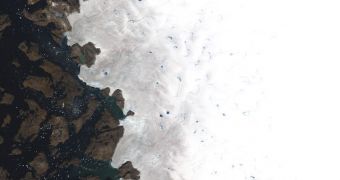Antarctica, the Arctic and Greenland play critical roles in determining the overall evolution of Earth's climate, say researchers, and this is why studying them in great detail could also provide hints for the future, in addition to helping augment existing climate models.
The ice sheets and glaciers covering these areas act on the planetary climate through a variety of means, but the most important one is solar reflection. Being white, ice reflects a huge portion of the sunlight reaching our planet back into space.
It stands to reason that less light means that less heat is trapped by our planet's greenhouse effect. This is one of the main protection mechanisms that our planet has against being overheated by the Sun.
But human-induced global warming is interfering with this natural mechanism. Excess greenhouse gases in the air are forcing more heat to be retained in the atmosphere, and this in turn melts ice.
As this happens, the ice sheets reflect less light into space, further contributing to the ensuing vicious circle. A common side-effect is the melting of ice sheets, and ocean level rise.
When the world's waters wax and wane, they shift their circulation patterns, which are the most important factors determining weather around the globe, Daily Galaxy reports.
Instances when these regions played a critical role in Earth's climate have been recorded in perennial ices at these locations, and a recent expedition conducted in Antarctica sought to recover some of these records for analysis.
The “Wilkes Land Glacial History” Expedition was conducted as part of the Integrated Ocean Drilling Program (IODP). The samples collected spanned a period of time ranging back to approximately 53 million years ago.
It was discovered that, at the time, Antarctica was a warm, sub-tropical environment. The period is known as the “hothouse world,” when carbon dioxide levels in the atmosphere were ten times larger than the ones today.
In less than 400,000 years (a glimpse in geological time), the continent transitioned from being warm to being covered in a miles-thick ice sheet, analysis of the collected samples revealed.
“These sediments are essential to our research because they preserve the history of the Antarctic ice sheet,” says Research Council of Spain (CSIC) and University of Granada expert Dr. Carlota Escutia, who was co-leader of the study.
“We can read these sediments like a history book,” adds the other co-chief scientist of the expedition, Dr. Henk Brinkhuis of Utrecht University in the Netherlands.
“And this book goes back 53 million years, giving us an unprecedented record of how ice sheets form and interact with changes in the climate and the ocean,” he concludes.

 14 DAY TRIAL //
14 DAY TRIAL //